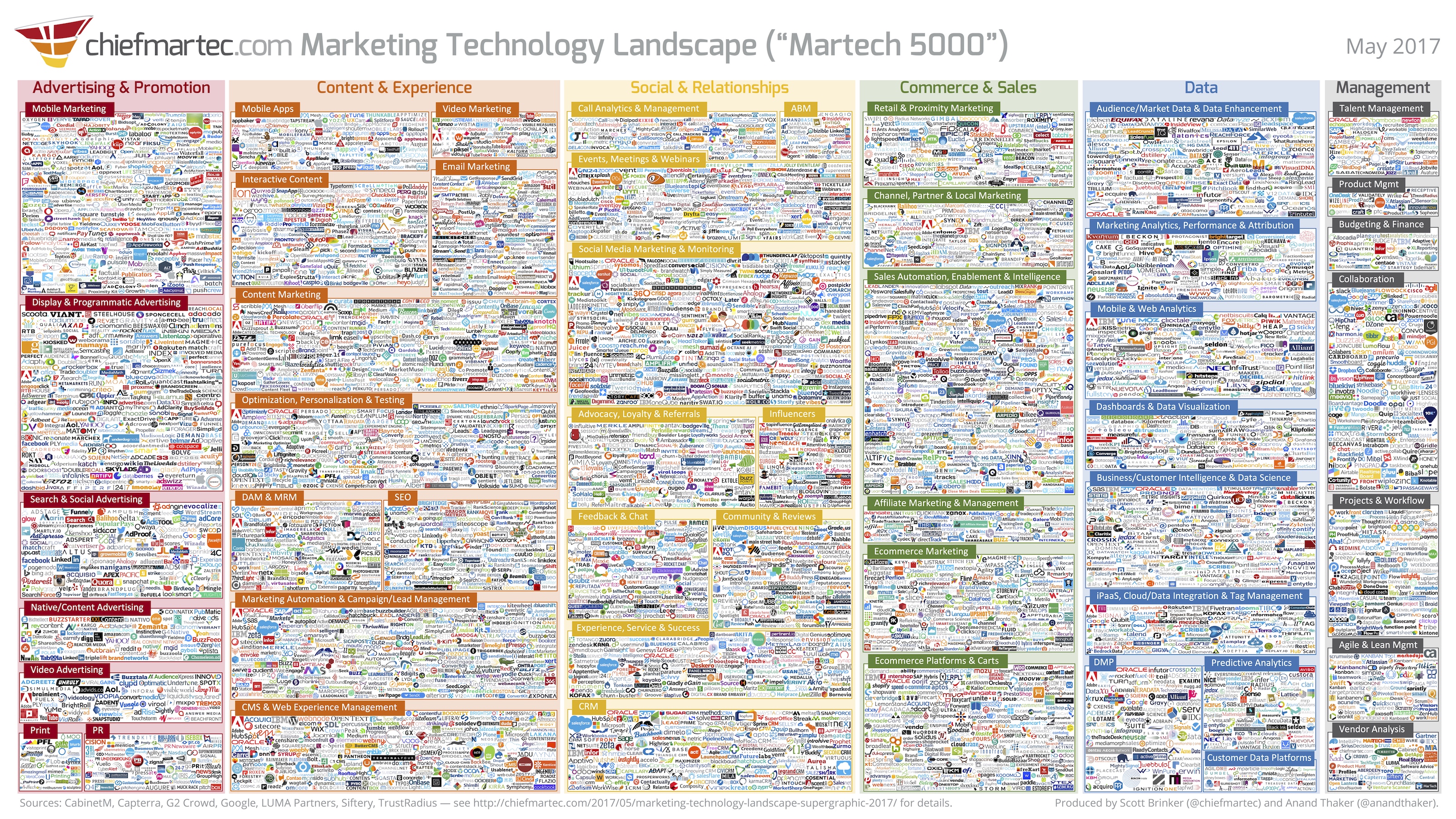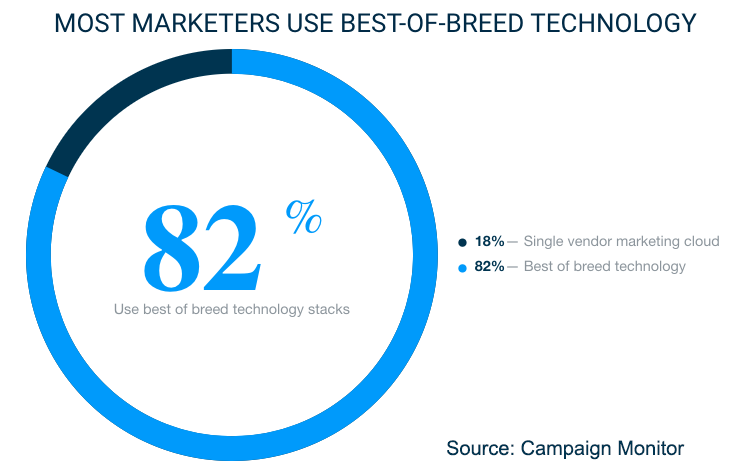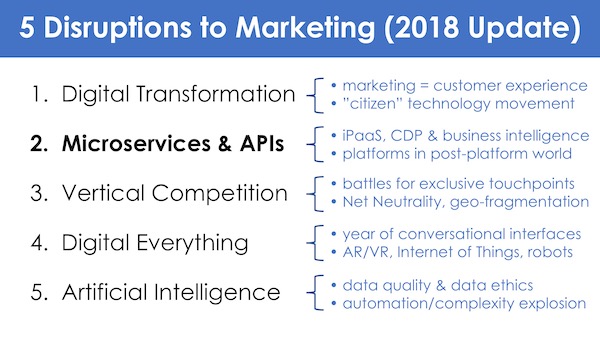
The Rise of Decentralized Martech and the Cosmic Shift of Marketing Automation
About the Author: David York has spent the last 15 years at the forefront of the martech revolution, and is an expert on its past, present and future.
The Rise of Marketing Automation
In 2003, I sat in an office with a salesperson from Eloqua. The pitch was simple and powerful: take multiple disparate systems and combine them into one fluid system. Marketing Automation (MA) would unite web analytics, email marketing and landing pages under one roof, opening the door to a wealth of previously unknown customer insights, saving time, and in my case, a whole lot of money. It was a no-brainer, and I signed up immediately.

Four years later, I joined Eloqua as an evangelist to the B2B marketing world, touting the manifold advantages of Digital Body Language (DBL), a subject that Eloqua co-founder, Steven Woods literally wrote the book on. DBL describes the assemblage of web and email activity data into a single, chronological view of a contact’s interactions with a business. It was the ultimate customer insight tool and an important competitive advantage MA provided. Countless companies were buying into its promise and experiencing great results.
As MA grew in popularity, so did the expectations regarding the problems it could solve. Customers were asking for more features, and as a salesperson, it pained me to say “no” at any point in the conversation. Fortunately, Woods, the CTO at Eloqua during this time had the foresight to develop a specific set of APIs that extended Eloqua’s capabilities within automation workflows to outside solutions. The answer wasn’t “no” anymore, but “yes,” albeit with the caveat that you had to build the bridge for your outside solution or find a vendor who could. I saw the unique opportunity Eloqua was offering to both MA customers and developers of outside solutions, and so I ventured out on my own to become a “bridge-builder,” so to speak. I spent the next few years building a ton of tech solutions for customers of Eloqua and other MA systems that integrated with the aforementioned APIs. The solutions I developed allowed people to customize and enhance the capabilities of their MA systems.
The Rise of Decentralized Martech

2017 Marketing Technology Landscape
For years, MA dominated the martech scene, and given its significant cost and large-scale adoption, I believe it will continue to be a key component in every marketer’s stack — but change is now upon us. The rapid expansion and adoption of marketing technologies chronicled by Scott Brinker in Chief Martech’s annual marketing technology landscape visually demonstrates the power shift occurring in martech. Whereas MA was once the central figure around which all marketing technology revolved, it is now one of many critical technologies in a martech stack.
An easy way to visualize this change is to imagine MA as the sun in the center of the martech solar system. However, if you expand your view to see a bigger picture, you’ll see that the sun is merely a star within a collection of stars that comprise a galaxy. Yes, MA is still a big star, but it is no longer the central figure around which everything revolves in martech’s ever-expanding universe. There are now a variety of systems that have starring roles throughout the stages of a marketing and sales cycle; no one system controls them all.

Problem #1: Decentralized Data Creates a Fragmented View of Customers and Prospects
Having a centralized view of accounts gives companies a powerful advantage. It equips marketers with deeper and more meaningful insights into customer behavior, and enables them to engage in more effective marketing. It also helps build brand loyalty by empowering marketers to create more personal, relevant and rewarding experiences for customers and prospects.
Most marketers have at their disposal 10 or more technologies to engage with customers and prospects. However, more often than not, all the data from this tech is not being assembled anywhere to create a single view of an account’s interactions over time. To address this issue, the concept of a Customer Data Platform (CDP) is on the rise, but the technology up to this point has primarily been focused on serving B2C companies by processing vast amounts of transactional web and ecommerce data. In the B2B realm, CDPs are starting to gain traction, but there is still a long way to go given the complexities that exist in managing Account-Based Marketing and other B2B necessities.
Problem #2: Decentralized Marketing Tools Create Complex Workflows, Reducing Productivity
While technology is inherently designed to increase efficiency, too much tech often has the opposite effect on our lives. Introducing new technology into your daily workflow often leads to the creation of many manual or semi-automated tasks in order to get systems to work together. When you combine these workarounds with the steps required by the user interface of each tool, the inefficiencies can become a liability. In addition, working like this is not scalable as it creates an environment of diminishing returns for companies that grow their marketing stacks from 10 to 20 to 30 different tools. Yes, the added technology allows a company to market in more ways, but the benefits are often hamstrung by resource constraints (thanks to burdensome manual processes), thus marketers never realize the full value of their tech investment.

Brinker’s Top 5 Marketing Disruptions
All of the previously mentioned problems are the reason why integrations are becoming more and more important. In his post about the top marketing disruptions on the horizon, Brinker notes that integrations are critical to orchestrating a seamless customer experience, as well as accelerating technological innovation, and I couldn’t agree more. Creating integrations using microservices and connector-style platforms allows apps and tools to be broken into smaller pieces, which makes them easier to build, maintain, configure and connect.
Making Beautiful Music Together
When you consider that there are now over 5,000 martech tools available, and each marketer’s stack is as unique as a thumbprint, the common denominator among those whose stacks are operating efficiently and effectively and those who are still struggling to make it all work is connection. Think of your stack as an orchestra, an eclectic collection of potentially amazing instruments (tools). In this scenario, your users are the musicians and customers are your audience. As the conductor of this orchestra, your first step is to create connectivity, so that a meaningful symphony is played that resonates with both users and customers. However, if you have tools that are loosely connected, it leads to disconnected data, marketing missteps and striking a wrong note with customers. In short, when things are connected as a hodgepodge, the result resembles the amateur efforts of a sixth-grade band. It’s a painful UX that customers can’t wait to disengage from. Conversely, when tools are well-connected it leads to a superior experience and increased engagement, which is ultimately what every marketer is after.
In 2015, I took my experience gained from years as an enterprise marketer, and from providing marketing automation customers and partners with integration services, and created Sureshot Labs. Sureshot was born out of the idea that in order for marketing tech to work well, it must be connected well. Connections must be both data- and people-centric. What do I mean by that? If one of the biggest problems of martech decentralization is reduced productivity from too many tools, then successful integrations must become easier for marketers to use. In order to stay ahead of the curve, companies that have adopted multiple solutions need for those solutions to talk to one another, and they need these connections to be simple and seamless, instead of the often cumbersome process most are currently experiencing. The connector framework links tools at the data level and provides simple interfaces that make orchestrating multiple tools across a stack possible. Instead of logging into several platforms to execute a campaign, imagine choosing an action from a single app and then having all your marketing tools support that action by operating in unison on the backend.
The Future of Martech
As I said before, MA is still a key player in everyone’s stack, only now it’s one of many key players, thanks to a decentralized approach brought on by the growing practice of marketers preferring best-of-breed stacks. As the adoption of new martech continues to grow, so will the challenges created by a lack of connectivity. Matthew Sweezey, the Principal of Marketing Insights at Salesforce.com put it this way, “The future of marketing and lead generation requires an automation 2.0 framework.” This framework is one that not only connects everything, but empowers tools to work together and deliver more significant data insights. It is my prediction that companies that connect their tech well will be equipped for success, regardless of the inevitable rises and falls that marketing technology brings.
